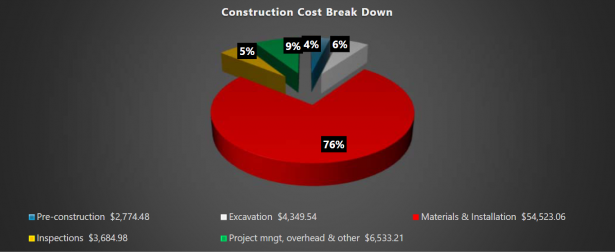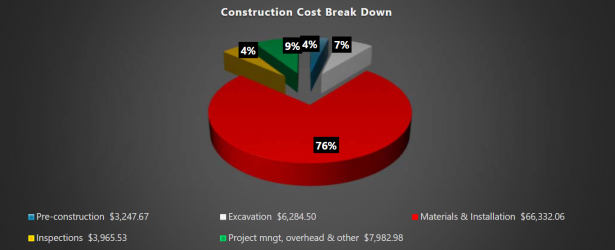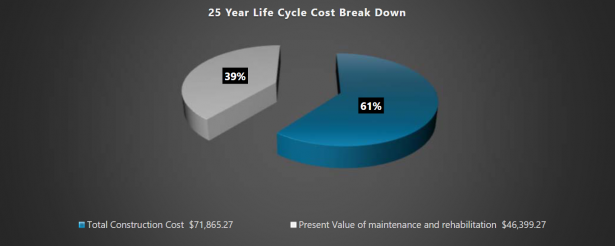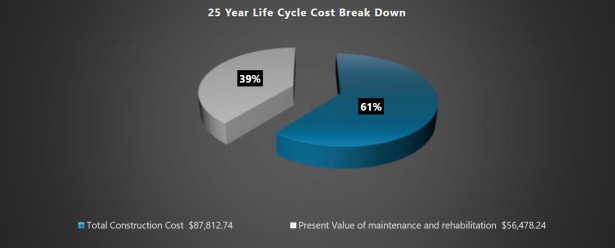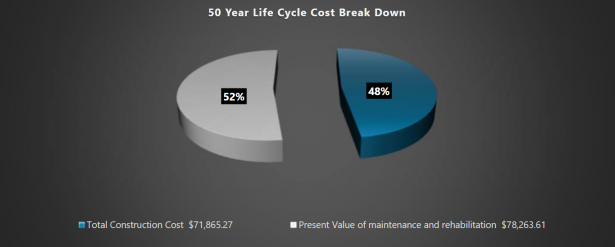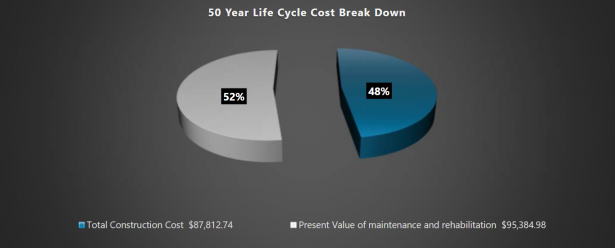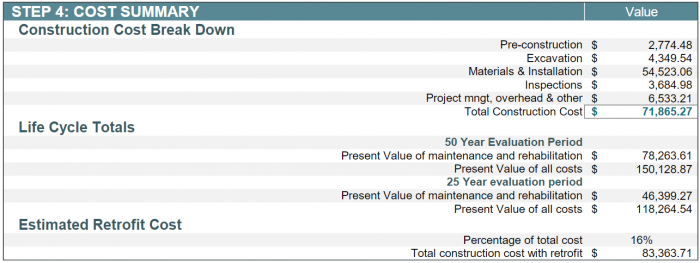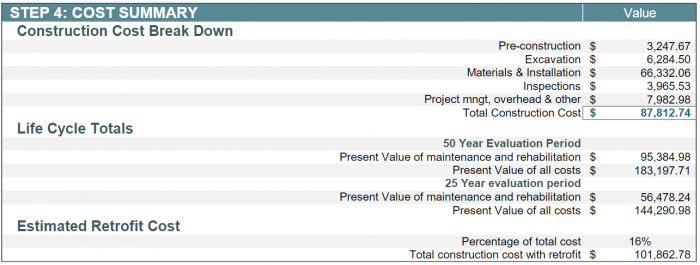Infiltration Trench: Life Cycle Costs
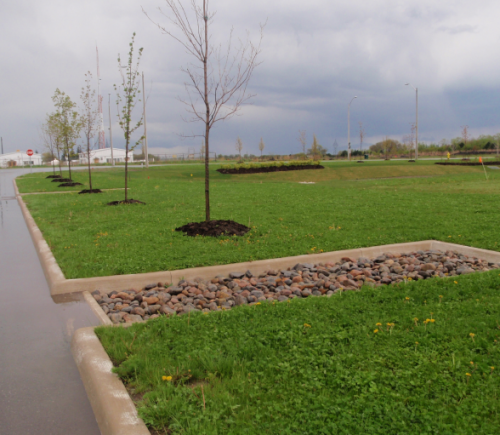
Overview[edit]
Infiltration trenches typically consist of linear-oriented, rectangular- or trapezoidal-shaped trench excavations between 0.6 and 2.4 m wide that are lined with geotextile, backfilled with clear stone aggregate and located underground. They are well suited to sites where available space for infiltration is limited to strips of land between buildings or properties, or along road right-of-ways. Trench depth is determined by the infiltration rate of the underlying native soil and maximum acceptable time to fully drain the facility (i.e., drainage time). STEP has prepared life cycle costs estimates for infiltration trenches located on highly permeable native soil (Full Infiltration design), and moderately permeable native soil (Partial Infiltration design) scenarios for comparison. Cost estimates for both design scenarios are based on a 2,000 m2 asphalt drainage area, runoff control target of 25 mm depth and 72 hour drainage period, which can be viewed below. To generate your own life cycle cost estimates customized to the development context, design criteria, and constraints applicable to your site, access the updated LID Life Cycle Costing Tool (LCCT) here.
Design Assumptions[edit]
Infiltration trenches are an ideal technology for installing below any type of landscape with requirements to infiltrate excess stormwater while safely conveying excess flows during major storm events. Components include: reservoir aggregate to store runoff water, perforated pipe to deliver and distribute flow to the trench, geotextile, inlet structures, pretreatment devices or features and monitoring wells to track drainage performance of the facility over its operating lifespan. Optional components include a flow restrictor to control the release rate of the facility, and surface drains to safely convey flows in excess of the storage capacity of the design.
Design and operation and maintenance program assumptions used to generate cost estimates are based on tool default values and the following STEP recommendations:
- Native soil infiltration rates for Full, and Partial Infiltration Design scenarios were assumed to be 20 mm/h and 10 mm/h respectively, and a safety factor of 2.5 was applied to calculate the design infiltration rate.
- Operation and maintenance (O&M) cost estimates assume annual inspections, removal of trash and debris twice a year, removal of sediment from pretreatment structures annually. Verification inspections are included every 5 years to confirm adequate maintenance, and every 15 years to confirm adequate drainage performance through in-situ trench water level monitoring during natural storm events.
- Trench width of 2.0 metres.
- Maximum impervious drainage area to permeable surface area (I:P area) ratio of 20:1.
- Trench depth of 580 mm and surface area of 198.73 m2 (I:P area ratio of 10:1) on 20 mm/h native soil (Full Infiltration Design)
- Trench depth of 290 mm and surface area of 366.58 m2 (I:P area ratio of 5.5:1) on 10 mm/h native soil (Partial Infiltration Design)
Notes[edit]
- Designs include pretreatment through two (2) hydrodynamic separators (i.e., oil and grit separators) located upstream of trench inlets, and two (2) 150 mm diameter monitoring wells per trench.
- The tool calculates costs for new (greenfield) development contexts and includes costs for contractor overhead and profit, material, delivery, labour, equipment (rental, operating and operator costs), hauling and disposal.
- Land value and equipment mobilization and demobilization costs are not included, assuming BMP construction is part of overall development site construction.
- Design and Engineering cost estimates are not calculated by the tool and must be supplied by the user.
- The tool adds 10% contingency and additional overhead as default.
- All cost estimates are in Canadian dollars and represent the net present value (NPV) as the tool takes into account average annual interest and discount rates over the 25 and 50 year operating life cycle periods.
- Unit costs are based on 2018 RSMeans standard union pricing.
- Additional costs associated with retrofit or redevelopment contexts is assumed to be 16% of the cost estimate for new (greenfield) construction contexts.
- Retrofit construction cost estimates are included in the 'Costs Summary' section for comparison.
- Retrofit construction cost estimates are included in the 'Costs Summary' section for comparison.
Construction Costs[edit]
Note: Click on each image to enlarge to view associated construction cost estimates.
Above you can find breakdowns of construction costs by expense type for each infiltration trench design scenario:
As can be seen, regardless of design configuration, Material & Installation expenses represent the largest portion of total construction costs (76%).
Life Cycle Costs[edit]
Below are capital and life cycle cost estimates for the two infiltration trench configurations over 25- and 50-year time periods. The estimates of maintenance and rehabilitation (life cycle) costs represent net present values. Operation and maintenance costs are predicted to represent 39% of total life cycle costs over the 25-year evaluation period, and increase to 52% of total life cycle costs over the 50-year period, due flushing of inlet, distribution and outlet pipes every 10 years.
25-Year life cycle cost break down[edit]
Note: Click on each image to enlarge to view associated life cycle cost estimate.
50-Year life cycle cost break down[edit]
Note: Click on each image to enlarge to view associated life cycle cost estimate.
Cost Summary Tables[edit]
Total life cycle cost estimates over the 50 year evaluation period for the two infiltration trench design configurations vary substantially with the Infiltration Trench: Partial Infiltration design being highest ($183.197.71), followed closely by the Infiltration Trench: Full Infiltration design being ($150,128.87).
It is notable that a sensitivity analysis was conducted in 2019 to compare construction cost estimates generated by the tool to actual costs of implemented projects. The analysis found that tool estimates were typically within ±14% of actual construction costs[2]
Full Infiltration[edit]
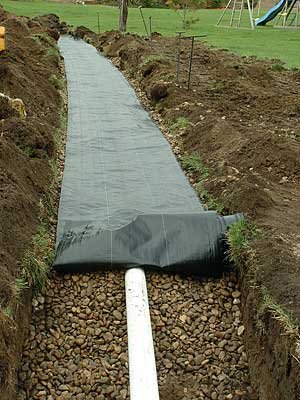
Partial Infiltration[edit]
References[edit]
- ↑ Hydrologic Assessment of LID Honda Campus, Markham, ON - TECHNICAL BRIEF. Accessed Dec 19 2022. https://sustainabletechnologies.ca/app/uploads/2015/07/Honda_TechBrief_July2015.pdf
- ↑ Credit Vally Conservation (CVC). 2019. Life-cycle costing tool 2019 update: sensitivity analysis. Credit Valley Conservation, Mississauga, Ontario. https://sustainabletechnologies.ca/app/uploads/2020/04/LCCT-Sensitivity-Analysis_March2020.pdf
- ↑ Performance Comparison of Surface and Underground Stormwater Infiltration Practices - TECHNICAL BRIEF. Low Impact Development Series. https://sustainabletechnologies.ca/app/uploads/2016/08/BioVSTrench_TechBrief__July2015.pdf
